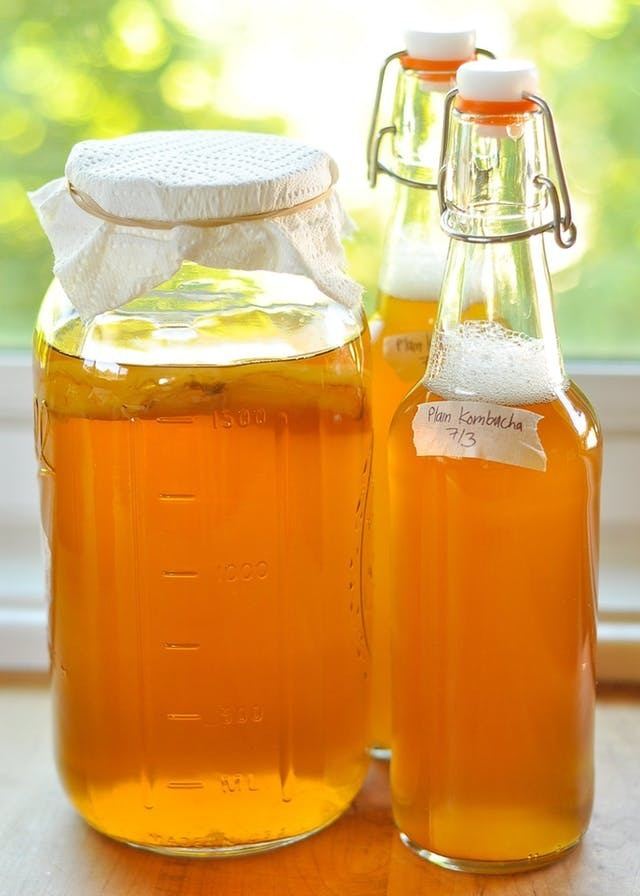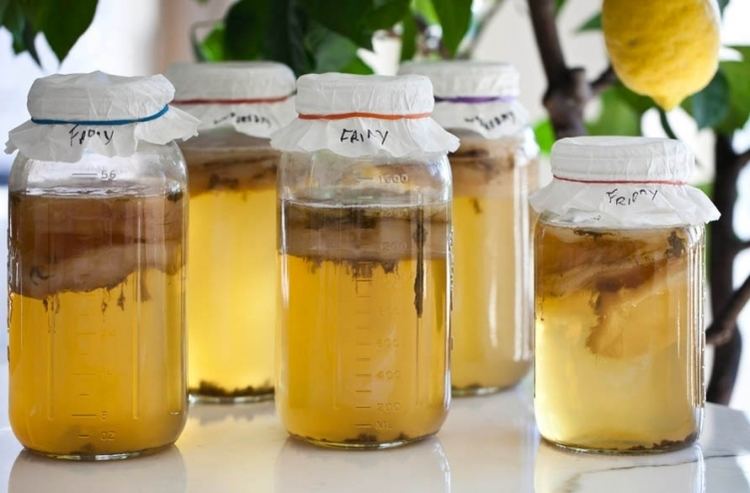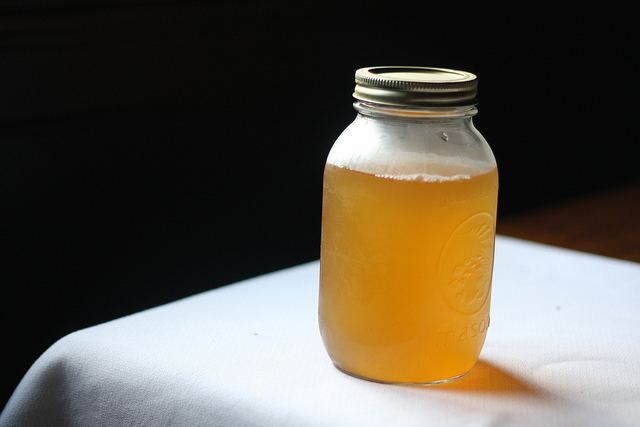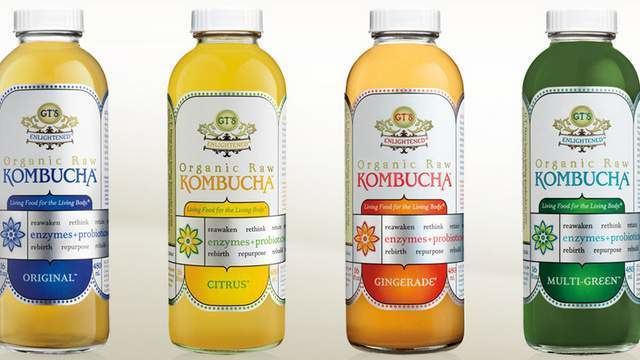 | ||
Similar | ||
How to make kombucha
Kombucha (also tea mushroom, Manchurian mushroom, formal name: Medusomyces gisevii) is a variety of fermented, lightly effervescent sweetened black or green tea drinks that are commonly intended as functional beverages for their supposed health benefits. Kombucha is produced by fermenting tea using a "symbiotic 'colony' of bacteria and yeast" (SCOBY). Actual contributing microbial populations in SCOBY cultures vary, but the yeast component generally includes Saccharomyces and other species, and the bacterial component almost always includes Gluconacetobacter xylinus to oxidize yeast-produced alcohols to acetic and other acids.
Contents
- How to make kombucha
- Beginners guide to fermentation kombucha making
- Health claims
- Adverse effects
- Other uses
- Biological
- Chemical
- Etymology
- Production
- History
- References

Although it has been claimed to have numerous health benefits, there is no good evidence that drinking kombucha has such effects. By contrast, there are several documented cases of serious adverse effects, including fatalities, related to kombucha drinking, possibly arising from contamination during home preparation. Since the mostly unclear benefits of kombucha drinking do not outweigh the known risks, it is not recommended for therapeutic use.

Kombucha originated in what is now Manchuria around 220 BCE, and was traditionally used primarily in that region and in Russian and eastern Europe. It is said to have been imported to Japan in 414 CE by the physician Kombu.

Beginners guide to fermentation kombucha making
Health claims

Kombucha has been promoted with claims that it can treat a wide variety of human illnesses, including AIDS, cancer, and diabetes, and that it provides other beneficial effects such as stimulation of the immune system, boosting the libido, and reversal of gray hair. Many people use it for medicinal purposes. However, evidence of kombucha's beneficial effects in humans is absent.

In a 2003 systematic review, Edzard Ernst characterized kombucha as an "extreme example" of an unconventional remedy because of the great disparity between implausible, wide-ranging health claims lacking evidentiary support, and the potential for harm the preparations seem to hold. Ernst concluded that the unsubstantiated list of proposed therapeutic benefits did not outweigh the known risks, and that kombucha should not be recommended for therapeutic use.
Adverse effects

Reports of adverse effects related to kombucha consumption are rare. It is unclear whether this is because adverse effects are rare, or just underreported. The American Cancer Society says that "Serious side effects and occasional deaths have been associated with drinking Kombucha tea".
Adverse effects associated with kombucha consumption include severe hepatic (liver) and renal (kidney) toxicity as well as metabolic acidosis. At least one person is known to have died after consuming kombucha, though the drink itself has never been conclusively proved a cause of death.
Some adverse health effects may be due to the acidity of the tea, which can cause acidosis, and brewers have been cautioned to avoid over-fermentation. Other adverse health effects may be a result of bacterial or fungal contamination during the brewing process. Some studies have found the hepatotoxin usnic acid in kombucha, although it is not known whether the cases of damage to the liver are due to the usnic acid contamination or to some other toxin.
Topical use of the tea has been associated with anthrax infection on the skin in one report, but kombucha contamination may have occurred during storage.
Due to its microbial sourcing and possible non-sterile packaging, kombucha is not recommended in people with poor immune function, in women who are pregnant or nursing, or in children under 4 years old.
Other uses
Kombucha culture, when dried, becomes a leather-like textile known as a microbial cellulose that can be molded onto forms to create seamless clothing. Using different broth media such as coffee, black tea, and green tea to grow the kombucha culture results in different textile colors, although the textile can also be dyed using plant-based dyes. Different growth media and dyes also change the textile's feel and texture.
Biological
A kombucha culture is a symbiotic culture of bacteria and yeast (SCOBY), similar to mother of vinegar, containing one or more species each of bacteria and yeasts, which form a zoogleal mat known as a "mother." The cultures may contain one or more of the yeasts Saccharomyces cerevisiae, Brettanomyces bruxellensis, Candida stellata, Schizosaccharomyces pombe, and Zygosaccharomyces bailii.
The bacterial component of kombucha comprises several species, almost always including Gluconacetobacter xylinus (G. xylinus, formerly Acetobacter xylinum), which ferments alcohols produced by the yeasts into acetic and other acids, increasing the acidity and limiting ethanol content. The population of bacteria and yeasts found to produce acetic acid has been reported to increase for the first 4 days of fermentation, decreasing thereafter. G. xylinum has been shown to produce microbial cellulose, and is reportedly responsible for most or all of the physical structure of the "mother", which may have been selectively encouraged over time for firmer (denser) and more robust cultures by brewers.
In Chinese, the microbial culture producing kombucha is called xiaomu in Mandarin and haomo in Cantonese, meaning, literally, "fermentation mother" (Chinese: 酵母).
The mixed, presumably symbiotic culture has been further described as being lichenous, in accord with the reported presence of the known lichenous natural product usnic acid, though as of 2015, no report appears indicating the standard cyanobacterial species of lichens in association with kombucha fungal components.
Chemical
Sucrose is converted, biochemically, into fructose and glucose, and these into gluconic acid and acetic acid, and these substances are present in the drink. In addition, kombucha contains enzymes and amino acids, polyphenols, and various other organic acids; the exact quantities of these items vary between preparations. Other specific components include ethanol (see below), glucuronic acid, glycerol, lactic acid, usnic acid (a hepatotoxin, see above), and B-vitamins. Kombucha has also been found to contain vitamin C.
The alcohol content of the kombucha is usually less than 1%, but increases with fermentation time.
Etymology
The word kombucha is of uncertain etymology. The American Heritage Dictionary suggests that it is probably from the "Japanese kombucha, tea made from kombu (the Japanese word for kelp perhaps being used by English speakers to designate fermented tea due to confusion or because the thick gelatinous film produced by the kombucha culture was thought to resemble seaweed)."
The English word, kombucha, has some 80 other names worldwide. A 1965 mycological study called kombucha "tea fungus" and listed other names: "teeschwamm, Japanese or Indonesian tea fungus, kombucha, wunderpilz, hongo, cajnij, fungus japonicus, and teekwass". Some further spellings and synonyms include combucha and tschambucco, and haipao, kargasok tea, kwassan, Manchurian fungus or mushroom, spumonto, as well as the misnomers champagne of life, and chai from the sea.
In Japanese, the term konbucha (昆布茶?, "kelp tea") refers to a different beverage made from dried and powdered kombu (an edible kelp from the Laminariaceae family).
Production
Commercially bottled kombucha became available in the late 1990s. In 2010, elevated alcohol levels were found in many bottled kombucha products, leading retailers including Whole Foods to temporarily pull the drinks from store shelves. In response, kombucha suppliers reformulated their products to have lower alcohol levels. By 2014 US sales of bottled kombucha were $400 million; $350 million of that was earned by Millennium Products, Inc. which sells "GT's Kombucha". In 2014, the market was projected to have 30% growth, and companies that make and sell kombucha formed a trade organization, Kombucha Brewers International. In 2016, PepsiCo purchased kombucha maker KeVita for approximately $200 million.
History
The origin of kombucha is uncertain. One theory is that it originated in what is now Manchuria around 220 BCE, and is said to have been imported to Japan around 400 CE by the physician Kombu.
The drink is reported to have been consumed in east Russia at least as early as 1900, and from there entered Europe. In 1913, kombucha was first mentioned in German literature. At least as early as the mid-1990s, it became popular in the US.
